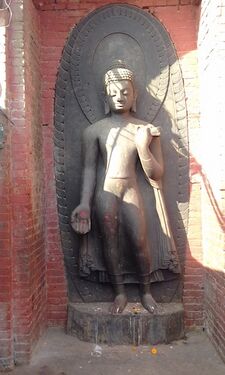Swayambhunath
Swayambhu is an ancient religious complex atop a hill in the Kathmandu Valley, west of Kathmandu city. The complex consists of a stupa, a variety of shrines and temples, some dating back to the Licchavi period.
The stupa at this site, Swayambhunath Stupa (Skt. Svayaṃbhūnāth Stūpa; Eng. The Self-Arisen Stūpa), known as "Phakpa Shingkün" in Tibetan (T. 'phags pa shing kun འཕགས་པ་ཤིང་ཀུན་; Eng. Sublime Trees of All Kinds), is one of the most sacred stupas in Nepal.[1] This site is also known locally as “The Monkey Temple,” due to the large number of monkeys which live in and around the temple complex.
Along with the stupas at Boudhanath and Namo Buddha, Swayambhunath is considered one of the three great stupas in Nepal. The origin of this stupa is recounted in the Swayambhu Purana, which details the history and significance of every major Buddhist site within the valley.[1]
Further reading
- Swayambhu: The Naturally Arisen Stupa, Nekhor
 Swayambhunath, Rigpa Shedra Wiki
Swayambhunath, Rigpa Shedra Wiki- Swayambhunath (Wikipedia)
- Swayambhunath Stupa, Lonely Planet
 Prayer to the Svayambhunath Stupa by Jamyang Khyentse Chökyi Lodrö, Lotsawa House
Prayer to the Svayambhunath Stupa by Jamyang Khyentse Chökyi Lodrö, Lotsawa House Prayer to the Three Stūpas of Nepal by Jamyang Khyentse Chökyi Lodrö, Lotsawa House
Prayer to the Three Stūpas of Nepal by Jamyang Khyentse Chökyi Lodrö, Lotsawa House Prayer to the Three Great Stupas of Kathmandu by Dudjom Rinpoche, Lotsawa House
Prayer to the Three Great Stupas of Kathmandu by Dudjom Rinpoche, Lotsawa House
Notes
- ↑ 1.0 1.1
 Swayambhunath, Rigpa Shedra Wiki
Swayambhunath, Rigpa Shedra Wiki

